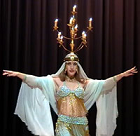
Zouba el Kloubatiyya was the first dancer to use a klob (candle lantern) balanced on her head during a zeffa, the Egyptian wedding procession. Shafia el Koptia, "The Coptic Christian", not to be outdone, used the shemadan (candelabra) as well. Shafia taught Nadia Hamdi''s grandmother and aunt. Nezla el Adel, a contemporary of Shafia, is still alive today and occasionally teaches and performs. She is in her 90''s. Nadia Hamdi is Egypt''s current diva of Shemadan and is the only dancer who was taught from the original line of Egyptian Shemadan dancers. Nadia was exposed to the teachings of Zouba as a child and then more formally trained by her grandmother.
Shemadan dancing as part of the Egyptian zeffa began in the early 20th century. Prior to that time, the zeffa was lead by a dancer and musicians but illumination was provided only by special three foot long decorated wedding candles and by lanterns held by members of the wedding procession. The special wedding candles remain a part of the wedding zeffa to this day.
The zeffa procession traditionally occurs at night, winding its way through the streets of the neighborhood from the home of the bride''s parents to her new home at the groom''s house. This is the official moving of the bride and is led by a dancer, musicians and singers, followed by the wedding party and their friends and family.
There are special musical pieces with a specific rhythm that is known colloquially as the zeffa beat. This is the appropriate music to use when leading a zeffa. Since the late 1970''s, as some wedding parties in Egypt became more urban and modernized, the zeffa moved along with the party into a hotel setting. In a hotel, the zeffa will occur down the central staircase and into the reception room where it will circle the room and deposit the wedding couple at their special flowered thrones at one end of the room. After the zeffa is completed, the dancer will use additional zeffa music or some other appropriate music to get the bride up to dance, then the groom, and then get the couple to dance together. The dancer may then also do a solo candelabra dance which includes floorwork. This is a theatrical performance for entertainment, separate from the zeffa procession.Alternately, the bride and groom and the wedding party will celebrate the marriage at a hotel nightclub.
The zeffa is an Egyptian wedding ritual but many couples of other Middle Eastern nationalities have adopted it as part of their wedding celebration, incorporating it along with their own rituals. Shemadan is also performed in theatricalized and folkloric performance settings, and it is a native, folkloric dance form indigenous to Egypt.
Bellydance Articles
Home
Guest book
|

